University Economics: Business Principles and Decision Making Analysis
VerifiedAdded on 2023/01/23
|6
|1078
|24
Homework Assignment
AI Summary
This economics assignment delves into key concepts of business and economics, including economies of scale, GDP, and the measurement of poverty and income inequality. The assignment begins by exploring how cities can be viewed as examples of economies of scale, analyzing both internal and external factors contributing to this phenomenon. A table is provided to analyze cost structures and determine the shutdown point for a firm. The assignment then defines GDP, explains how poverty is measured in low-income countries using absolute and relative thresholds, and clarifies the distinction between poverty and income inequality. The solution provides clear explanations, definitions, and calculations to enhance understanding of these core economic principles. References to relevant sources are also included.
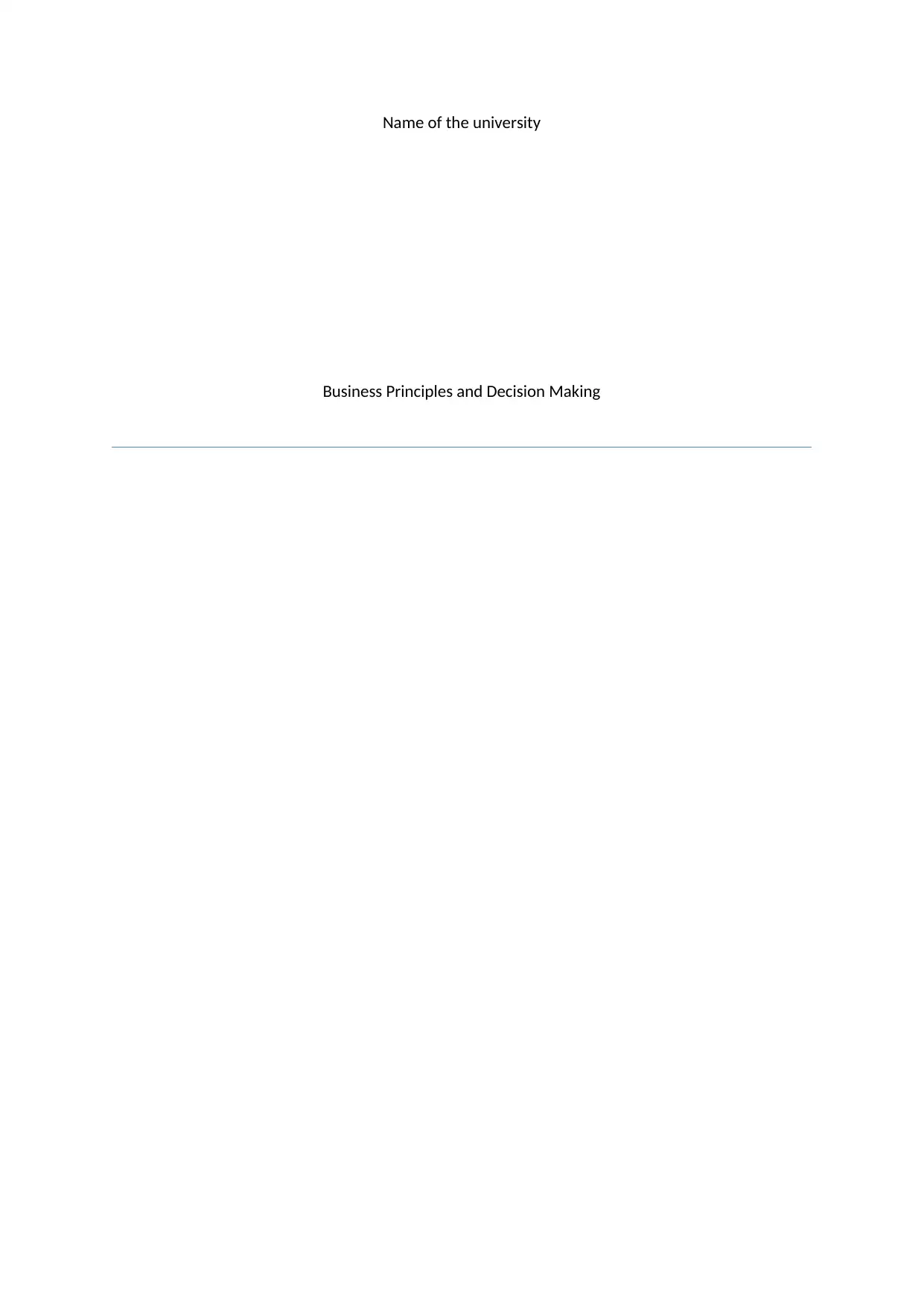
Name of the university
Business Principles and Decision Making
Business Principles and Decision Making
Paraphrase This Document
Need a fresh take? Get an instant paraphrase of this document with our AI Paraphraser
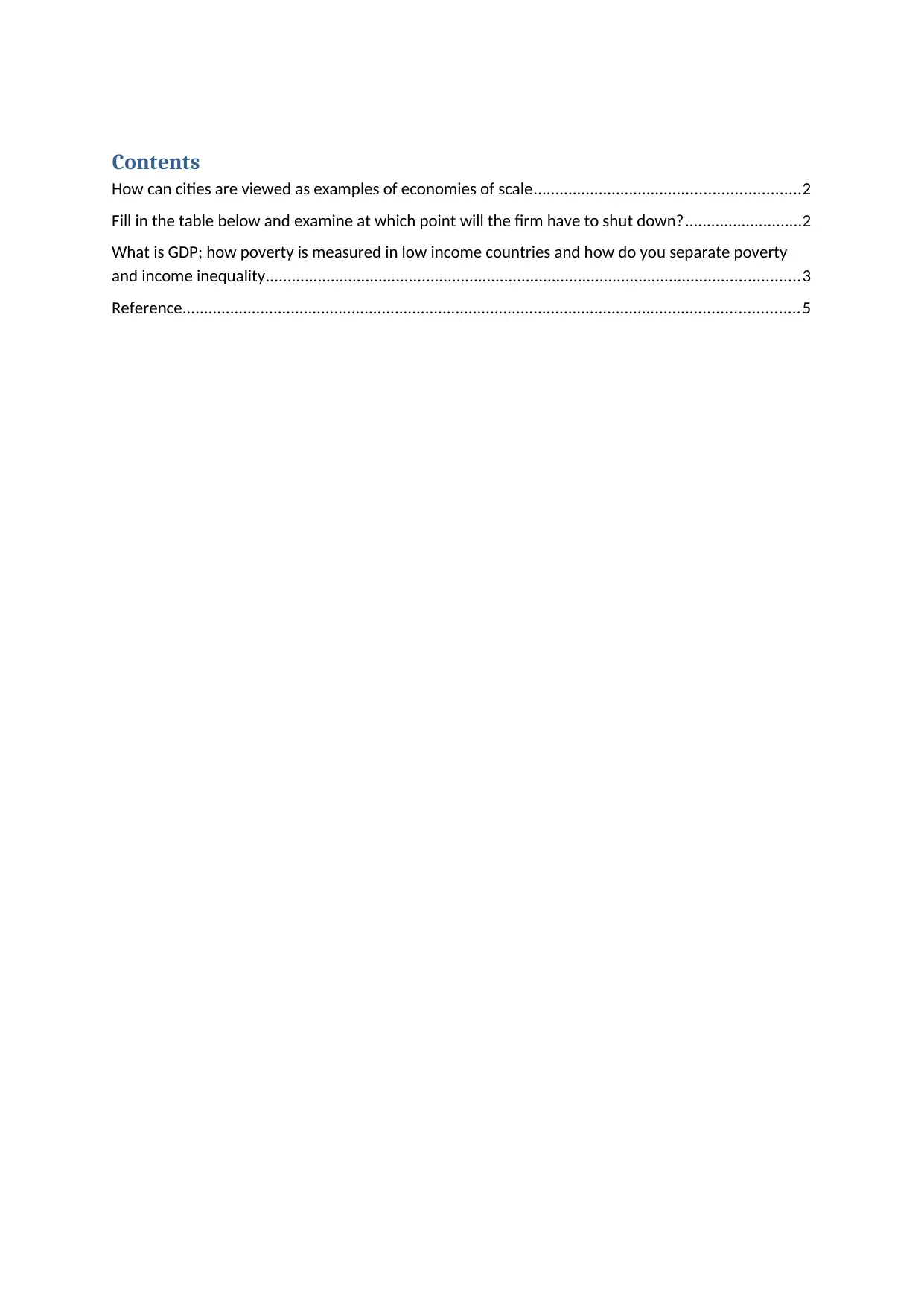
Contents
How can cities are viewed as examples of economies of scale.............................................................2
Fill in the table below and examine at which point will the firm have to shut down?...........................2
What is GDP; how poverty is measured in low income countries and how do you separate poverty
and income inequality...........................................................................................................................3
Reference..............................................................................................................................................5
How can cities are viewed as examples of economies of scale.............................................................2
Fill in the table below and examine at which point will the firm have to shut down?...........................2
What is GDP; how poverty is measured in low income countries and how do you separate poverty
and income inequality...........................................................................................................................3
Reference..............................................................................................................................................5
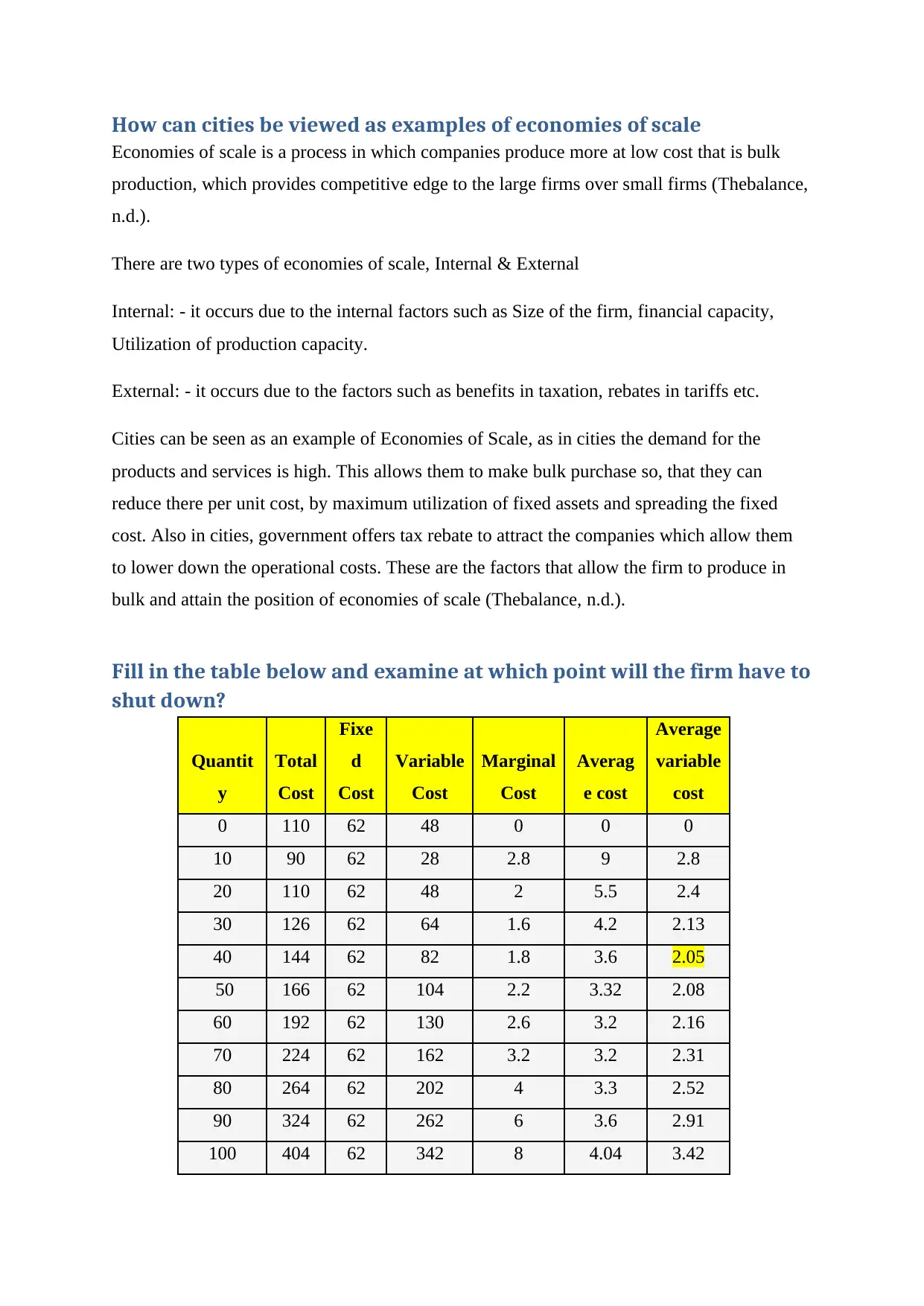
How can cities be viewed as examples of economies of scale
Economies of scale is a process in which companies produce more at low cost that is bulk
production, which provides competitive edge to the large firms over small firms (Thebalance,
n.d.).
There are two types of economies of scale, Internal & External
Internal: - it occurs due to the internal factors such as Size of the firm, financial capacity,
Utilization of production capacity.
External: - it occurs due to the factors such as benefits in taxation, rebates in tariffs etc.
Cities can be seen as an example of Economies of Scale, as in cities the demand for the
products and services is high. This allows them to make bulk purchase so, that they can
reduce there per unit cost, by maximum utilization of fixed assets and spreading the fixed
cost. Also in cities, government offers tax rebate to attract the companies which allow them
to lower down the operational costs. These are the factors that allow the firm to produce in
bulk and attain the position of economies of scale (Thebalance, n.d.).
Fill in the table below and examine at which point will the firm have to
shut down?
Quantit
y
Total
Cost
Fixe
d
Cost
Variable
Cost
Marginal
Cost
Averag
e cost
Average
variable
cost
0 110 62 48 0 0 0
10 90 62 28 2.8 9 2.8
20 110 62 48 2 5.5 2.4
30 126 62 64 1.6 4.2 2.13
40 144 62 82 1.8 3.6 2.05
50 166 62 104 2.2 3.32 2.08
60 192 62 130 2.6 3.2 2.16
70 224 62 162 3.2 3.2 2.31
80 264 62 202 4 3.3 2.52
90 324 62 262 6 3.6 2.91
100 404 62 342 8 4.04 3.42
Economies of scale is a process in which companies produce more at low cost that is bulk
production, which provides competitive edge to the large firms over small firms (Thebalance,
n.d.).
There are two types of economies of scale, Internal & External
Internal: - it occurs due to the internal factors such as Size of the firm, financial capacity,
Utilization of production capacity.
External: - it occurs due to the factors such as benefits in taxation, rebates in tariffs etc.
Cities can be seen as an example of Economies of Scale, as in cities the demand for the
products and services is high. This allows them to make bulk purchase so, that they can
reduce there per unit cost, by maximum utilization of fixed assets and spreading the fixed
cost. Also in cities, government offers tax rebate to attract the companies which allow them
to lower down the operational costs. These are the factors that allow the firm to produce in
bulk and attain the position of economies of scale (Thebalance, n.d.).
Fill in the table below and examine at which point will the firm have to
shut down?
Quantit
y
Total
Cost
Fixe
d
Cost
Variable
Cost
Marginal
Cost
Averag
e cost
Average
variable
cost
0 110 62 48 0 0 0
10 90 62 28 2.8 9 2.8
20 110 62 48 2 5.5 2.4
30 126 62 64 1.6 4.2 2.13
40 144 62 82 1.8 3.6 2.05
50 166 62 104 2.2 3.32 2.08
60 192 62 130 2.6 3.2 2.16
70 224 62 162 3.2 3.2 2.31
80 264 62 202 4 3.3 2.52
90 324 62 262 6 3.6 2.91
100 404 62 342 8 4.04 3.42
⊘ This is a preview!⊘
Do you want full access?
Subscribe today to unlock all pages.

Trusted by 1+ million students worldwide
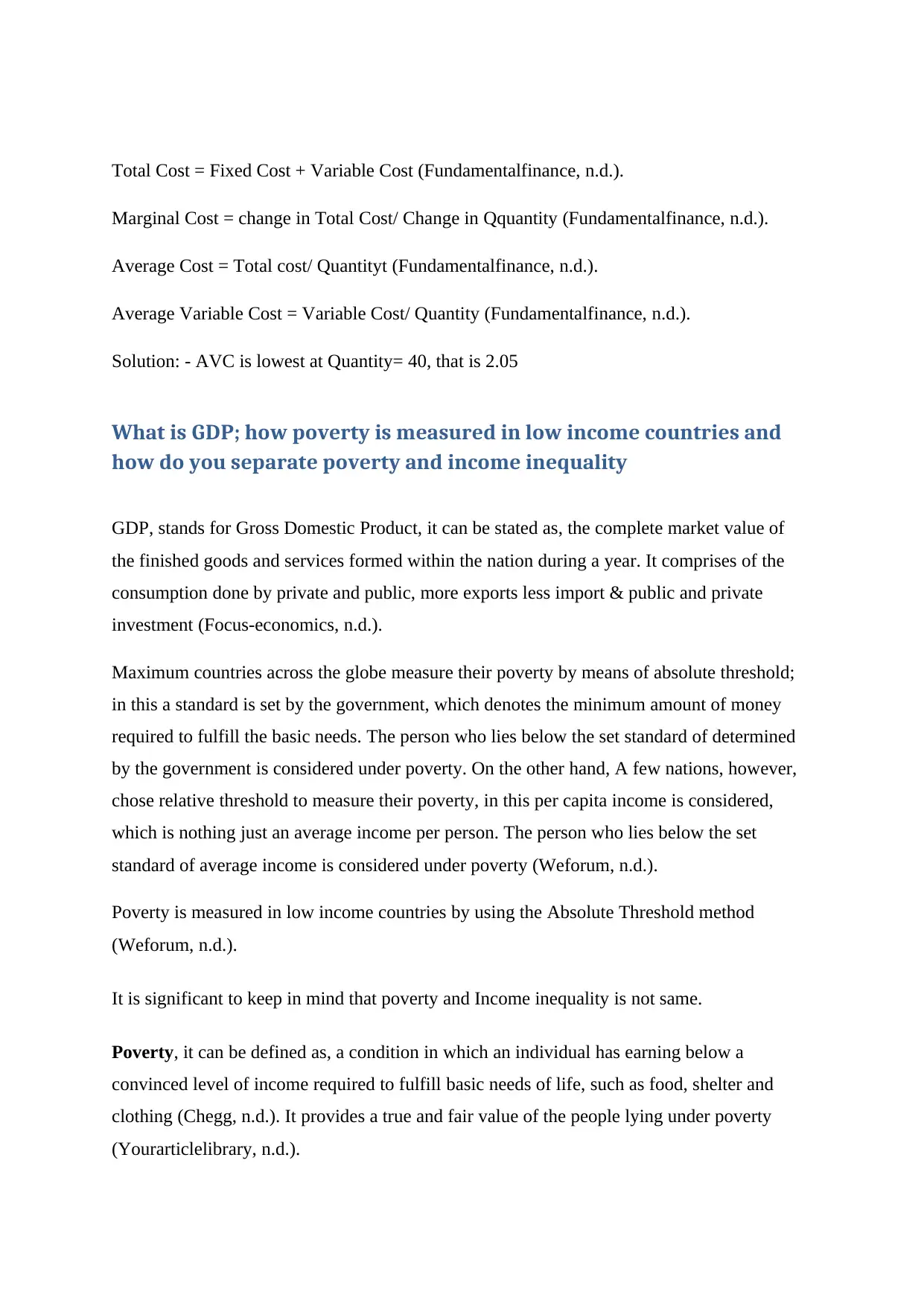
Total Cost = Fixed Cost + Variable Cost (Fundamentalfinance, n.d.).
Marginal Cost = change in Total Cost/ Change in Qquantity (Fundamentalfinance, n.d.).
Average Cost = Total cost/ Quantityt (Fundamentalfinance, n.d.).
Average Variable Cost = Variable Cost/ Quantity (Fundamentalfinance, n.d.).
Solution: - AVC is lowest at Quantity= 40, that is 2.05
What is GDP; how poverty is measured in low income countries and
how do you separate poverty and income inequality
GDP, stands for Gross Domestic Product, it can be stated as, the complete market value of
the finished goods and services formed within the nation during a year. It comprises of the
consumption done by private and public, more exports less import & public and private
investment (Focus-economics, n.d.).
Maximum countries across the globe measure their poverty by means of absolute threshold;
in this a standard is set by the government, which denotes the minimum amount of money
required to fulfill the basic needs. The person who lies below the set standard of determined
by the government is considered under poverty. On the other hand, A few nations, however,
chose relative threshold to measure their poverty, in this per capita income is considered,
which is nothing just an average income per person. The person who lies below the set
standard of average income is considered under poverty (Weforum, n.d.).
Poverty is measured in low income countries by using the Absolute Threshold method
(Weforum, n.d.).
It is significant to keep in mind that poverty and Income inequality is not same.
Poverty, it can be defined as, a condition in which an individual has earning below a
convinced level of income required to fulfill basic needs of life, such as food, shelter and
clothing (Chegg, n.d.). It provides a true and fair value of the people lying under poverty
(Yourarticlelibrary, n.d.).
Marginal Cost = change in Total Cost/ Change in Qquantity (Fundamentalfinance, n.d.).
Average Cost = Total cost/ Quantityt (Fundamentalfinance, n.d.).
Average Variable Cost = Variable Cost/ Quantity (Fundamentalfinance, n.d.).
Solution: - AVC is lowest at Quantity= 40, that is 2.05
What is GDP; how poverty is measured in low income countries and
how do you separate poverty and income inequality
GDP, stands for Gross Domestic Product, it can be stated as, the complete market value of
the finished goods and services formed within the nation during a year. It comprises of the
consumption done by private and public, more exports less import & public and private
investment (Focus-economics, n.d.).
Maximum countries across the globe measure their poverty by means of absolute threshold;
in this a standard is set by the government, which denotes the minimum amount of money
required to fulfill the basic needs. The person who lies below the set standard of determined
by the government is considered under poverty. On the other hand, A few nations, however,
chose relative threshold to measure their poverty, in this per capita income is considered,
which is nothing just an average income per person. The person who lies below the set
standard of average income is considered under poverty (Weforum, n.d.).
Poverty is measured in low income countries by using the Absolute Threshold method
(Weforum, n.d.).
It is significant to keep in mind that poverty and Income inequality is not same.
Poverty, it can be defined as, a condition in which an individual has earning below a
convinced level of income required to fulfill basic needs of life, such as food, shelter and
clothing (Chegg, n.d.). It provides a true and fair value of the people lying under poverty
(Yourarticlelibrary, n.d.).
Paraphrase This Document
Need a fresh take? Get an instant paraphrase of this document with our AI Paraphraser
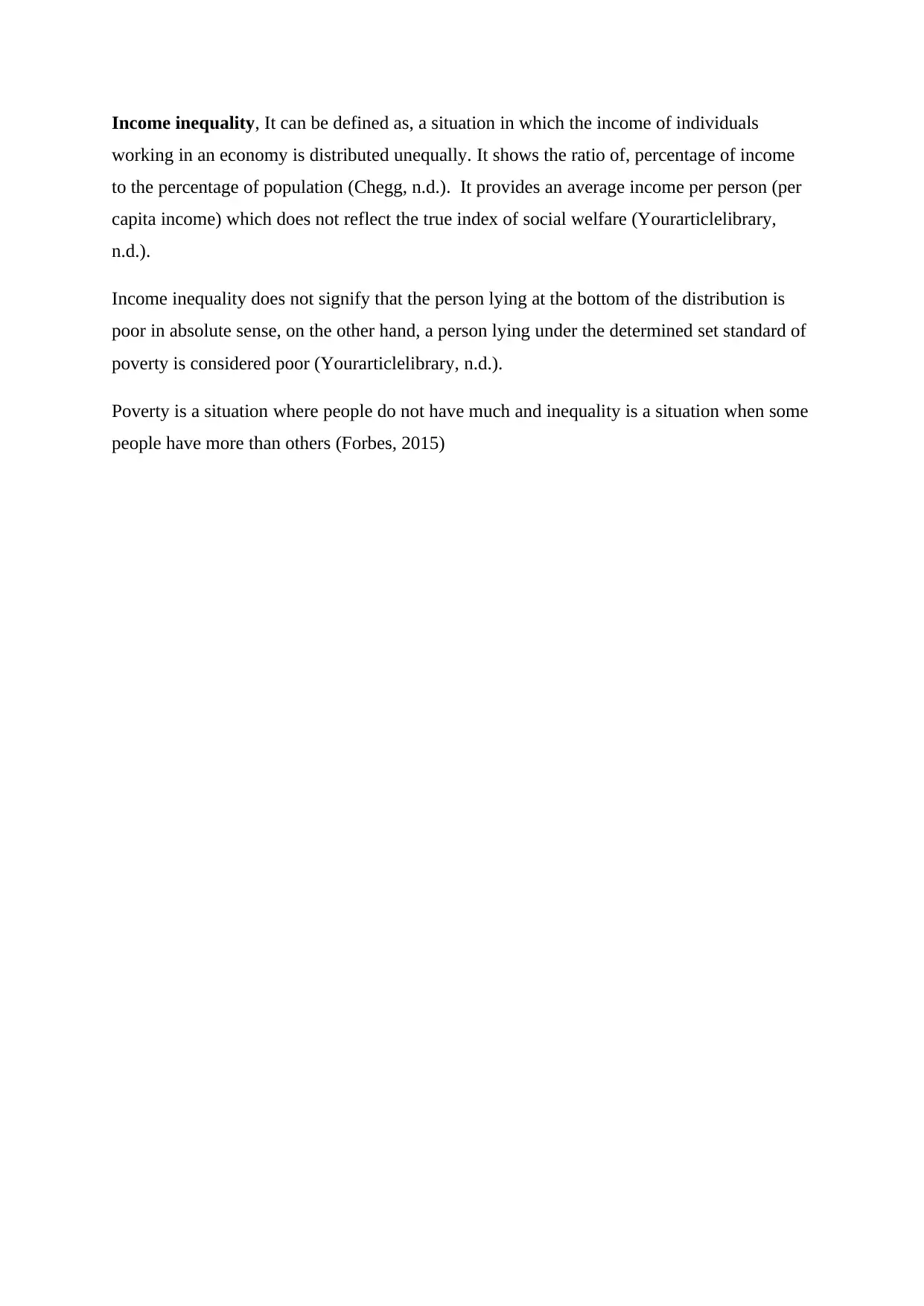
Income inequality, It can be defined as, a situation in which the income of individuals
working in an economy is distributed unequally. It shows the ratio of, percentage of income
to the percentage of population (Chegg, n.d.). It provides an average income per person (per
capita income) which does not reflect the true index of social welfare (Yourarticlelibrary,
n.d.).
Income inequality does not signify that the person lying at the bottom of the distribution is
poor in absolute sense, on the other hand, a person lying under the determined set standard of
poverty is considered poor (Yourarticlelibrary, n.d.).
Poverty is a situation where people do not have much and inequality is a situation when some
people have more than others (Forbes, 2015)
working in an economy is distributed unequally. It shows the ratio of, percentage of income
to the percentage of population (Chegg, n.d.). It provides an average income per person (per
capita income) which does not reflect the true index of social welfare (Yourarticlelibrary,
n.d.).
Income inequality does not signify that the person lying at the bottom of the distribution is
poor in absolute sense, on the other hand, a person lying under the determined set standard of
poverty is considered poor (Yourarticlelibrary, n.d.).
Poverty is a situation where people do not have much and inequality is a situation when some
people have more than others (Forbes, 2015)
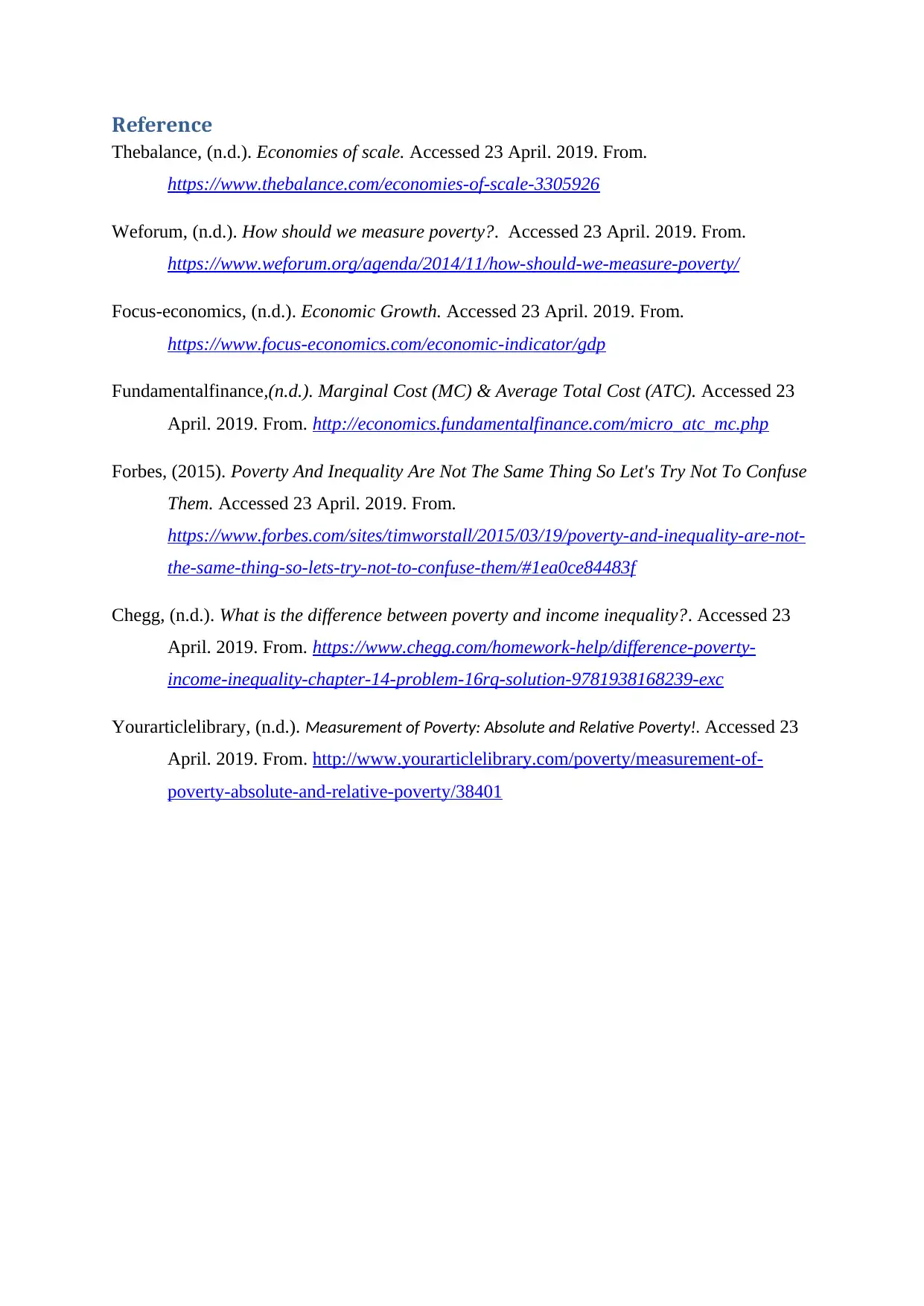
Reference
Thebalance, (n.d.). Economies of scale. Accessed 23 April. 2019. From.
https://www.thebalance.com/economies-of-scale-3305926
Weforum, (n.d.). How should we measure poverty?. Accessed 23 April. 2019. From.
https://www.weforum.org/agenda/2014/11/how-should-we-measure-poverty/
Focus-economics, (n.d.). Economic Growth. Accessed 23 April. 2019. From.
https://www.focus-economics.com/economic-indicator/gdp
Fundamentalfinance,(n.d.). Marginal Cost (MC) & Average Total Cost (ATC). Accessed 23
April. 2019. From. http://economics.fundamentalfinance.com/micro_atc_mc.php
Forbes, (2015). Poverty And Inequality Are Not The Same Thing So Let's Try Not To Confuse
Them. Accessed 23 April. 2019. From.
https://www.forbes.com/sites/timworstall/2015/03/19/poverty-and-inequality-are-not-
the-same-thing-so-lets-try-not-to-confuse-them/#1ea0ce84483f
Chegg, (n.d.). What is the difference between poverty and income inequality?. Accessed 23
April. 2019. From. https://www.chegg.com/homework-help/difference-poverty-
income-inequality-chapter-14-problem-16rq-solution-9781938168239-exc
Yourarticlelibrary, (n.d.). Measurement of Poverty: Absolute and Relative Poverty!. Accessed 23
April. 2019. From. http://www.yourarticlelibrary.com/poverty/measurement-of-
poverty-absolute-and-relative-poverty/38401
Thebalance, (n.d.). Economies of scale. Accessed 23 April. 2019. From.
https://www.thebalance.com/economies-of-scale-3305926
Weforum, (n.d.). How should we measure poverty?. Accessed 23 April. 2019. From.
https://www.weforum.org/agenda/2014/11/how-should-we-measure-poverty/
Focus-economics, (n.d.). Economic Growth. Accessed 23 April. 2019. From.
https://www.focus-economics.com/economic-indicator/gdp
Fundamentalfinance,(n.d.). Marginal Cost (MC) & Average Total Cost (ATC). Accessed 23
April. 2019. From. http://economics.fundamentalfinance.com/micro_atc_mc.php
Forbes, (2015). Poverty And Inequality Are Not The Same Thing So Let's Try Not To Confuse
Them. Accessed 23 April. 2019. From.
https://www.forbes.com/sites/timworstall/2015/03/19/poverty-and-inequality-are-not-
the-same-thing-so-lets-try-not-to-confuse-them/#1ea0ce84483f
Chegg, (n.d.). What is the difference between poverty and income inequality?. Accessed 23
April. 2019. From. https://www.chegg.com/homework-help/difference-poverty-
income-inequality-chapter-14-problem-16rq-solution-9781938168239-exc
Yourarticlelibrary, (n.d.). Measurement of Poverty: Absolute and Relative Poverty!. Accessed 23
April. 2019. From. http://www.yourarticlelibrary.com/poverty/measurement-of-
poverty-absolute-and-relative-poverty/38401
⊘ This is a preview!⊘
Do you want full access?
Subscribe today to unlock all pages.

Trusted by 1+ million students worldwide
1 out of 6
Your All-in-One AI-Powered Toolkit for Academic Success.
+13062052269
info@desklib.com
Available 24*7 on WhatsApp / Email
![[object Object]](/_next/static/media/star-bottom.7253800d.svg)
Unlock your academic potential
Copyright © 2020–2025 A2Z Services. All Rights Reserved. Developed and managed by ZUCOL.